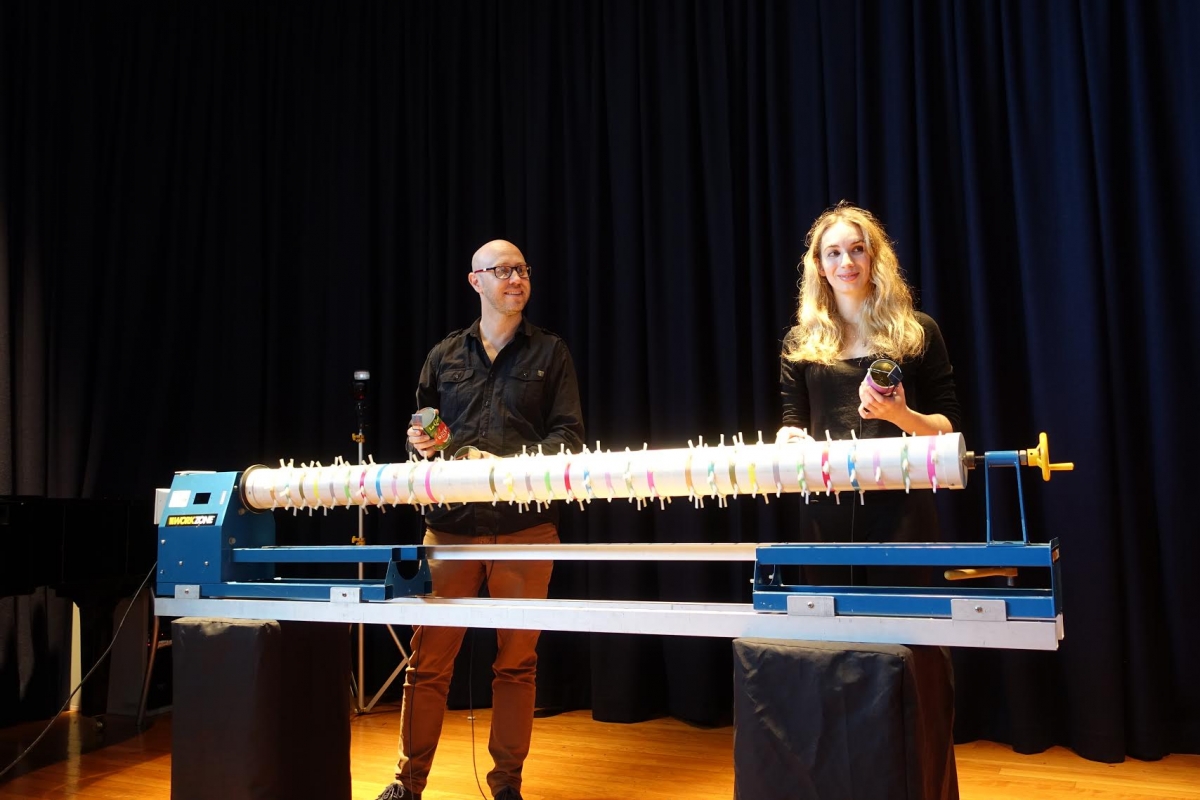★★★☆☆ Interactive installation blossomed with new music.
Right next door to the Garden of Light, the Sydney Conservatorium of Music’s own contribution to Vivid Sydney lit up the building with Sound Gardens, a miniature festival of light and new music under the auspices of its larger commercial cousin. Pitched as a “roving feast of new music and installations” the event spread from the Con’s Music Café and down the stairs to the Music Workshop that served as the festival’s Main Stage and featured two main sets, some more casual performances in the Music Café and a series of installations, curated by Damien Ricketson, Craig Scott and Clint Bracknell.
Sound Gardens presented work by the Con’s Composition, Contemporary Music, Music Technology and Jazz programmes and the first installation, Harry Burgess’s Luminous Impulse followed audience members down the staircase as they made their way to the Music Workshop, twists of electronic sounds warping and dipping – an exploration of how light could be imagined sonically.
 Damien Ricketson and Mimi Kind operating The Rhythm Machine at Sound Gardens
Damien Ricketson and Mimi Kind operating The Rhythm Machine at Sound Gardens
The event officially began in the Music Workshop with the husky tones of jazz trumpeter Thomas Avgenicos and his band. Sabrina Toon was the first of the ‘contemporary’ students to perform (contemporary in this usage referring to pop, indie rock, electronic dance music etc.) Her upbeat – if saccharine – performance given some weight by dancers Bianca King and Brayden Harry.
The highlight of the first set was Mimi Kind’s The Rhythm Machine, an instrument built by Kind from an industrial-sized wood lathe. The machine had three operators, Kind, Geena Cheung and Lilli Pearse, each holding amplified tin cans up to the spokes (which later turned out to be made from plastic cable ties). Kind herself controlled the speed of the rotating cylinder via controls on the side of the lathe. Each can was strung with a rubber band, the performers producing a variety of sounds and pitches by dampening and stretching the rubber with their fingers. The Rhythm Machine looks like a giant music box (or some kind of mechanical sound-loom) and produces a hypnotic, textural music that spools out with a Gamelan-like quality. (The machine was later moved into the foyer for audience members to learn to play – it requires a lot more refinement than one might imagine.)
Released to explore the festival, the audience was free to listen to more music in the Music Café – which had been conveniently turned into a bar – or browse installations like James Maher and Victoria Pam’s Pendulum, which suspended plastic and metal cutlery in glass jars, hooked up to motors that could be controlled by the audience from a midi-keyboard. The chaotic tinkling was then transformed electronically to create an atmospheric haze of sound.
The second set in the Music Workshop featured invited guests the Thymolphthalein Trio (Anthony Pateras, Natasha Anderson and Clayton Thomas). The set began with a vivid improvisation from Pateras on prepared piano and Thomas on prepared bass. The piano bubbled and murmered with exotic percussion sounds – almost faux-electronic textures – while the bass rumbled and rattled, Thomas producing sounds with drum sticks, scraping and what appeared to be a clipboard wedged through the strings. Delineated into sections, the performance was riveting, the piano at times sounding like a marimba and the arc of the improvisation sensitively controlled.
The premiere of The Hills Are Alive…With the Sound of Subsidy was less engaging, but still created an interesting soundscape. Pateras led the Con’s Contemporary Music Ensemble, augmented by the trio, from a revox tape machine (in a set-up not unlike a keyboardist leading from the harpsichord). The meandering work conjured a film-noir darkness with muted trumpet slides, scurrying strings, the hissing steam noise of air through instruments, and the white-noise crackle of steel wool on electric guitar strings. The piece faded out to the sounds of wind and forlorn piano clusters.
With night fallen and the Con lit up, the evening came to a close in the Music Café, Thibaud Kessell, a.k.a Mlekö, rounding out the festival with some slick electronics – his final number a “remix of a cover of Taylor Swift.”
Sound Gardens showcased the variety of ‘contemporary’ music being created by students at the Con and the festival atmosphere made for a relaxed and enjoyable experience in which audience members could wander through sounds and ideas in what felt like a more serene version of Cage’s Musicircus. Using the Music Workshop as the main stage, though, felt restrictive and somehow out of keeping with the sand-box freedom of the rest of the festival. The most interesting moments were the ones involving discovery, interaction and exploration.











Comments
Log in to join the conversation.